Abstract
Lithuanian energy landscape is changing because of a strong push to reduce carbon emissions and reliance of fossil-based energy production. EU climate directive promotes investments into carbon capture and storage technologies along with renewable energy resource development. CCUS, hydrogen and geothermal are some technologies which could promote reduction in carbon emissions and along with reducing dependence on fossil-based energy sources. Lithuania already has large potential for carbon and hydrogen storage and in past had a working geothermal power plant for district heating. In this work we revisit the carbon storage potential in Lithuania subsurface and provide a high-level estimate of potential of generating hydrogen energy from depleted hydrocarbon fields using in-situ methods. We also evaluate the prospects of development of geothermal energy production from deep Cambrian reservoirs where temperature above 85 °C has been documented.
1. Introduction
Carbon Capture Utilization and Storage (CCUS) is the most safeguard technology to meet the global change in the temperature as CO2 encounters 63 % of the global greenhouse gases. This technology can be met in several ways to meet the defined Net-Zero carbon or carbon neutral or expected to achieve 14-19 % of the reduction needed by 2050. In this process we capture the atmospheric or anthropogenic CO2 and sequester it in the subsurface which can reduce the global climate temperature rise. Out of the most promising technology the super critical CO2 subsurface injection can be represented as giga-tons storage sites to make the sites more valuable. The importance or end uses of CCUS is elaborated in Fig. 1. The most promising sites are depleted oil and gas reservoirs, saline reservoirs, coal seams and salt caverns. The sequestration process can be done by following means like Structural Trapping, Residual/Capillary Trapping, Solubility Trapping, and Mineral Trapping depending on the geological conditions [1-13].
Another source of renewable energy is Hydrogen energy which is also a key to shift towards a more sustainable future for humans, which will also enable tackling climate change issues. Hydrogen has a big potential as the combustion of 1 m3 of H2 produces 12.7 MJ of energy. It has two-to-three-fold times more energy content than natural gas, making it the fuel with the most energy content per unit mass. Also, it could be produced using thermochemical, electrolytic, biological, solar water splitting processes. Moreover, different formations like salt structures, aquifers, and crude oil and natural gas reservoirs, can be identified as potential hydrogen storage sites. Fig. 2 shows the different mechanisms for both renewable and non-renewable resources through which hydrogen can be produced.
Fig. 1End uses of CO2
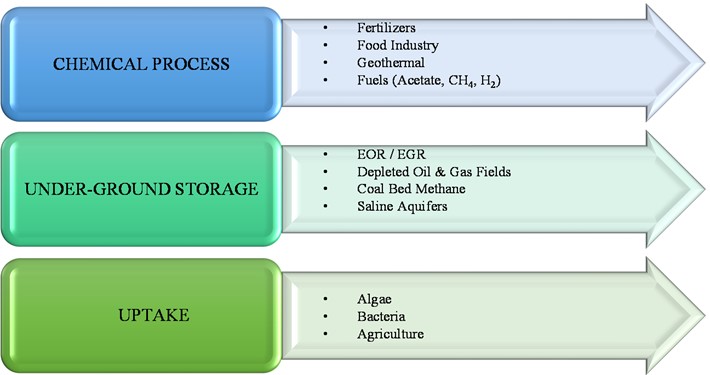
Fig. 2Routes to hydrogen production
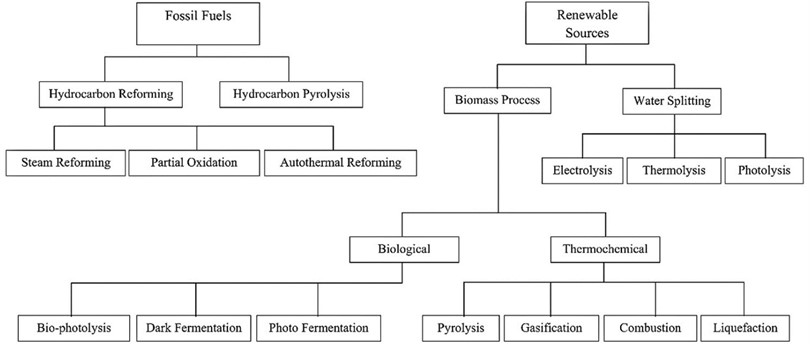
Moreover, due to the decline in conventional plays and transition to net-zero has not only attracted the above two technologies but also attracted Geothermal as an alternative resource. The other sources of renewable energy like Wind, Power, and Biomass are also in high demand and have been increasing in recent years. However, because of variable energy generation, the storage of renewable energy is an important factor to balance the generated power and consumption and plays an important role in maintaining sustainable resources.
Another important renewable energy source is geothermal energy, which is abundantly available in deep layers of earth crust. Lithuania is in the middle part of the European union. It has a big geothermal anomaly in the western part as compared to the eastern part. Moreover, it also has large resources for geo-energy up to a depth of 6000 mts. It also has many depleted or nearly depleted oil and gas reservoirs which are quantified for geo-energy analysis. That’s why Lithuania is increasing its potential into renewable energy resources, so it has more viable options for CCUS, Hydrogen storage and Geothermal. In this paper we discuss all the three renewable energy resources and their potential based on the analytical perspective.
2. Geo-energy resource (CCUS)
Lithuania has many near depleting oil and gas fields. Moreover, it has a growing potential of renewable resources, so it attracts many developing technologies. The western part of the Lithuania has a potential of CO2 sources and are located within prospective area of Cambrian reservoir which is one of the big CO2 sources within the Devonian strata [1]. Immature solubility and mineral trapping technologies can be considered as prospective. The importance and potentiality of CCUS has been observed in the depleting Gargzdai oil and gas reservoir which is considered as one single unified model in Lithuania. Another opportunity for CCUS is deep saline aquifers i.e. Syderiai and Vaskai because Lithuania has low enthalpy, highly saline geothermal complexes in the Cambrian and Lower Devonian region. Fig. 3 shows the oil and gas prospectus in the Baltic basin which are being considered for CCUS potential.
Fig. 3Hydrocarbon fields in Baltic basin
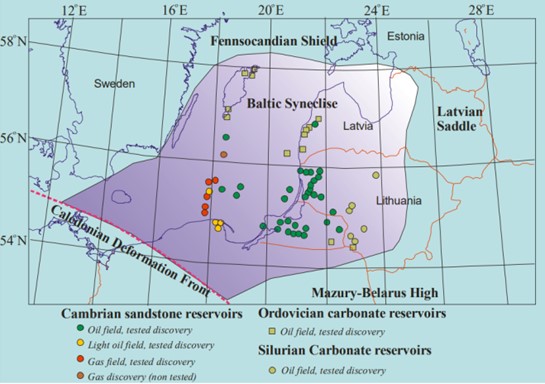
Fig. 4A sample sector/mechanistic model (conceptual plot)
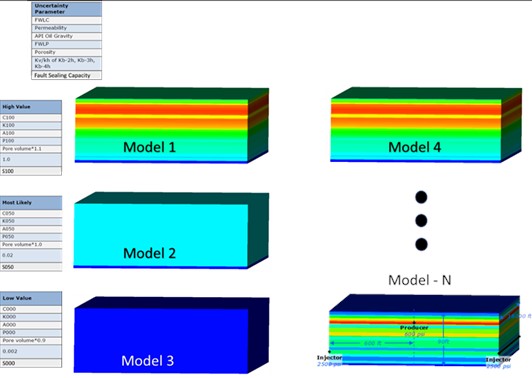
2.1. Methodology
To evaluate the potential of the geological sites for CCUS initially a mechanistic model has been developed. The model has all the features of the sector model based on the geological full field model as shown in Fig. 4. The mechanistic model of the Lithuanian Baltic basin has been developed based on average permeability, porosity, Net to Gross (NTG), and thickness. Each mechanistic model (static model) was further used for calculating the Original Oil in Place (OOIP) and performed uncertainty analysis by preparing the Tornado charts to rank the most effective parameters. The model was then history matched based on the available production data and used to generate LOW, MID and HIGH case. The detailed workflow of the methodology is shown in Fig. 5. For more details, please refer to [15].
Fig. 5Uncertainty management workflow methodology
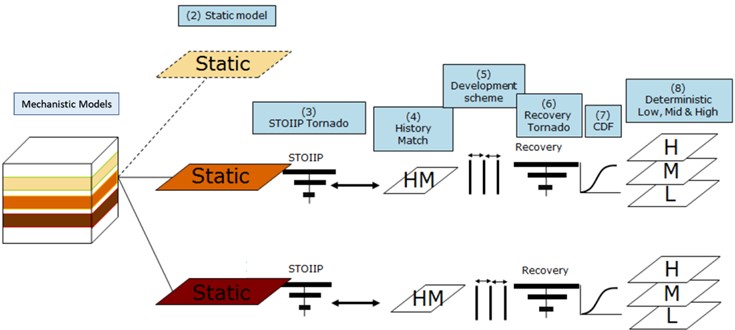
2.2. Results
Lithuania has a rather limited storage potential may be in terms of few decades. Two prospective structural traps, Vaškai and Syderiai, are the most defined site for the CCUS. They mostly from the major industrial CO2 sources, such as the Mažeikiai refinery or Akmenės Cementas. The prospects of the large-scale Gargždai uplift zone have also been considered which provide more potential by large volumes for storing CO2 in the Cambrian reservoir. The Table 1 summaries the CCUS storage potential for three different sites and cases (low, mid, and high) respectively.
Table 1CO2 storage potential in the selected sites
Sr. No | Reservoir | Cases | ||
Low | Mid | High | ||
1 | Syderiai (Mt) | 54 | 80 | 232 |
2 | Vaskai (Mt) | 25 | 37 | 106 |
3 | Gargzdai oil zone (Mt) | 64 | 94 | 267 |
3. Geo-energy resource (hydrogen production and storage)
As Lithuania pursues a rapid transition to renewable energy, it is becoming the first nation-wide study to be carried out on the development of the hydrogen sector which shows that Lithuania has the potential to become a significant player in the development and transportation of hydrogen resources in Europe. Lithuania is developing its opportunities to organize the production, storage, transfer, and export of hydrogen in the European Union. The study of hydrogen technology in Lithuania is mainly related to the use of hydrogen in the industrial use and exports. In addition, the successful application of hydrogen in the market would help reduce Lithuania’s dependence on oil and natural gas imports – the goal to become energy supplier.
3.1. Hydrogen production in the Baltic region
The Baltic region has many prospects for the fossil fuels and renewable sources. Out of which some of the storage methods may be suitable for certain industrial applications with limited volumes requirements but geological storage is the only viable solution for a large scale TWh deliverability [7]. The Baltic region is distinct by extensive coastline and have easy access to renewable resources which can be essential for producing electrolyzing green hydrogen. Electricity produced by offshore wind farms is used to separate water into molecules of hydrogen and oxygen, this process is known as electrolytic hydrogen generation. It is sustainable and environmentally friendly and a better way to manufacture hydrogen. Additionally, the Baltic region already has developed natural gas infrastructure that might be modified and used for transportation and distribution of hydrogen. Thus, this on-going Hydrogen projects in Baltic region as shown in Fig. 6 are going to help to achieve the ambition of production of 10 million tonnes and import 10 million tonnes of renewable hydrogen in the EU by 2030. The aim of these projects is to increase hydrogen production and improve the hydrogen transportation opportunities.
Fig. 6Ongoing hydrogen projects in Baltic region
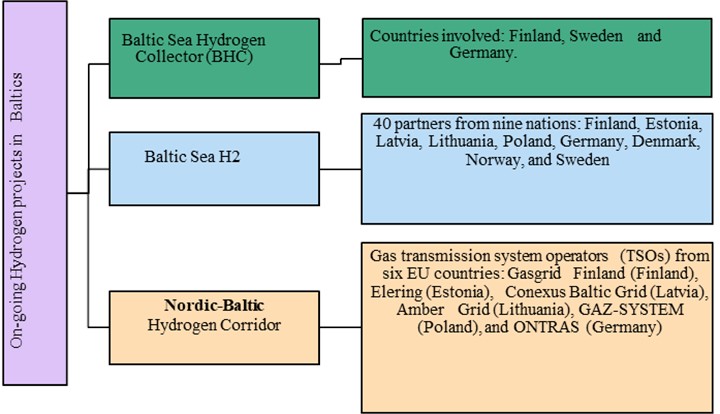
3.2. Hydrogen production from subsurface
The in-situ hydrogen productions are from fossil fuels or oil and gas reservoirs. A reservoir which has a high water cut or less efficient for enhanced oil recovery can be a good candidate for hydrogen production. This type of process is an original and affordable method of producing hydrogen from fossil fuel sources. To start combustion inside the reservoir, oxygen-enriched air must be injected into the reservoir. All hydrocarbon-based hydrogen synthesis requires the presence of all three essential components: heat, oxygen, and water (steam). At reservoir conditions, heat is present but not in sufficient quantity to start hydrogen producing processes, oxygen is absent, and water exists in varying salts (brine). The following hydrogen-forming reactions are anticipated during in situ combustion when oxygen is added to the reservoir: Partial Oxidation (POX), Steam Reforming (SR), and Autothermal Reforming (ATR), and Pyrolysis (PY).
In this study Gargzdai structure in Lithuania has been selected as a candidate for hydrogen production potential that has an oil zone containing close to a billion barrels of residual oil. All the residual oil could be a potential target for hydrogen production using the “Thermotoga petrophila” bacteria strain. In this method naturally occurring “Thermotoga petrophila” bacteria in hydrocarbon reservoirs are used to produce hydrogen through bio-refinement of crude oil. Basically, bacteria eat crude oil and produce hydrogen as a by-product. Moreover, there are several reservoirs of similar properties like the Gargzdai in terms of pressure and temperature zone that have shown potential for hydrogen production using thermophilic bacteria. Table 2 shows the estimates of hydrogen production potential from Gargzdai oil zone using analytical estimates.
Table 2Estimates of hydrogen production from the Gargzdai oil zone
Sr. No | H2produced | H2production 1 Liter of crude | H2 (Liters) produced from 1 bbl. of crude | H2 (Liters) produced from 1 Billion bbl. of crude | H2produced from 1 Billion bbl. of crude in Trillion Cubic Feet | H2produced from 1 Billion bbl. of crude in Million tons |
1 | Low Case | 1170 | 185913 | 1.85913E+14 | 6.6 | 184 |
2 | Mid Case | 1300 | 206570 | 2.06570E+14 | 7.2 | 200 |
3 | High Case | 1495 | 237555.5 | 2.37556E+14 | 8.3 | 231 |
4. Geo-energy resource (geothermal)
Lithuania is the third major geothermal potential country after Turkey and Iceland. As described earlier it has a big anomaly in the western part as compared to eastern part. In the western region there are two main potential geothermal aquifers with temperature ranges more than 45 °C (Lower Devonian) and 95 °C (Cambrian). There are other possibilities of enhanced geothermal system located at a depth more than 2000 mts with temperature exceeding 100 °C (up to 160 °C at 6000 mts). We tried to describe in brief about the geothermal potential in Lithuania and the construction and operation of Klaipeda geothermal plant (KGDP) which extracts heat from Lower Devonian aquifer. We also present a brief overview of the geological screening of geothermal sites and development of numerical model to evaluate the geothermal potential of the selected sites for commercial development.
Lithuania is the Middle European country and located on the eastern part of the Baltic-sea. It is rich in low enthalpy geothermal resources but has a big anomaly despite its location in the stable thick ancient tectonic plate that existed from the Cambrian Period. The anomaly is situated in the SW of the country, and it is related to Middle Proterozoic cratonic granitoid intrusions rich in radiogenic heat producing elements Th, U and K. Lithuania net energy consumption is reported as 50 GJ per capita (13 MW-hr.) [11] and therefore has more potential for geothermal resources. Currently Lithuania produces only 11 % of their renewable and indigenous resources and have a plan to produce 25 % by 2020, as a goal set by European Union. Most of the geothermal resources are in the western part of the Lithuania as compared to the eastern part of the country. In the western region, geothermal aquifers are located at a depth of 1000 mts to 2500 mts which consist of two potential thermal aquifers. There are other potential aquifers, but more emphasis is on the described two. The deeper one is the Cambrian geothermal which is located at a depth of 2000 mts with a temperature range of 75 to 90 °C. Above that another geothermal aquifer sits known as Lower Devonian which is located at a depth of 1000 mts having a geothermal temperature of 37 to 42 °C [11].
4.1. Historical view of geothermal development in Lithuania
The geothermal investigation in Lithuania started in 1987 to 1989. After then, first deep exploration well Vydmantai-1 has been drilled and 100 hard rock samples and 12 bed rock samples were collected and their thermophysical properties were estimated for the analysis. The well hole has passed through the entire sedimentary basin and completed in the Cambrian region from 2122 mts to 2564 mts [16]. Moreover, during the drilling several petrophysical logs, grain size, mineralogical analysis, filtration coefficient for Devonian layer, cracks, ground water chemistry, microelement contents along with thermophysical properties were determined.
In between 1992 and 1994 the Danish government financed a study of the geothermal potential in Lithuania and Latvia called “Baltic Geothermal Energy Project”. In this project they studied all regional aquifers within the Devonian and Cambrian strata along with the energy needs and geothermal potentials. While Germany funded the Vilkaviskis spa geothermal project and other project studies.
In 1993 the second well Vydmantai-2 was drilled and completed but due to lack of money the well was shut-in. From that period till 1999 almost 19 exploration wells have been drilled for evaluation. During the period from 1995 – 96, the site selection and geothermal potential was calculated, and Klaipeda was chosen for pilot location.
In 2000, Klaipeda Geothermal Demonstration Plant (KGDP) was constructed, and it was first project to be financed through the World Bank in which the geothermal energy is transferred to the district heating system using heat pump technology and circulated in the closed loop. The KGDP plant extracted geothermal water from the Lower Devoian strata at a temperature of 40 °C (estimated 42 °C) [13]. The total thermal capacity of the Klaipeda plant is 41 MW (geothermal 18 MW and 23 MW from boilers) and the amount of heat extracted in 2003 was about 215000 MW-hr. Initially, only injector 1I was drilled but it was not sufficient to inject the desired 700 m3/hr of geothermal water. Hence a new injector 4I had been drilled and till now KGDP plant has two production (KGDP-2P, KGDP-3P) and two injection (KGDP-1I, KGDP-4I) wells which are identical in design and completed at depth 1128 to 1228 mts.
Since from the start of the KGDP plant 2002 to 2010 the plant faced many operational difficulties due to precipitation of the gypsum and other minerals in both upstream and downstream lines. Furthermore, the plant also faced corrosion of materials, deposition, and degasification of N2 in the operational lines. During the entire period several stimulation and remedial actions have been performed including radial jet technology. But the effect of remedy was for minimal amount of time and proved unsuccessful. Since 2017, the plant has also faced many financial issues and has ceased operation. The Fig. 7 summarizes the historical overview of the geothermal operation in Lithuania.
Fig. 7Geothermal historical overview of Lithuania
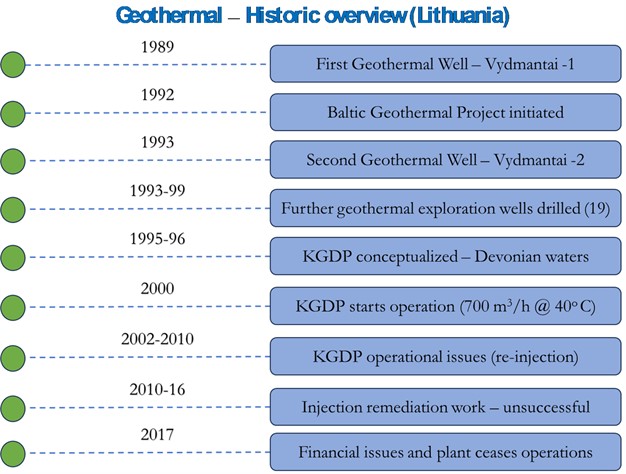
4.2. Direct use of sedimentary aquifers
Out of all the sedimentary layers the Cambrian and Lower Devonian are the main geothermal aquifers which are separated by Silurian-Ordovician carbonate (impermeable) rock aquitard. The geothermal heat from this sedimentary layer will be directly used for the district heating. The Cambrian geothermal complex consists of Dimena sandstone and are present from 1800 mts to 2100 mts with geothermal temperature of more than 95 °C. While the Middle-Lower Devonian sandstones in the Pärnu-Kemeri area is present from the 600 mts to 1100 mts with geothermal aquifer temperature of more than 46 °C. Both the aquifer has calculated potential of 2.5 MW and 15 MW respectively. The Cambrian has less efficiency because of less efficient reservoir properties.
To assess the geothermal potential of all the available sites in Cambrian region, 3D simulation models are being constructed. The initial step is to develop the geological screening criteria of sites based on the aquifer temperature. From those 3 topmost sites will be selected for future studies based on the geological uncertainty modelling workflow and techno-economical modelling. The study also includes depleted hydrocarbon sites because of high water cuts which may solve the problems of produced water re-injection. After initial data gathering numerical modeling will be conducted, with help of mechanistic box models, to evaluate the geothermal potential of the selected sites for commercial development. Fig. 8 shows the framework of the development of screening model for geothermal assessment.
Fig. 8Framework of development of screening models [15]
![Framework of development of screening models [15]](https://static-01.extrica.com/articles/23903/23903-img8.jpg)
4.3. Opportunity for enhanced geothermal systems (EGS) for electricity production
Depending on the volume of resources, the highest potential is in the crystalline basement rocks also known as Hot Dry Rocks (HDR) which are located at a depth of 4000 mts to 5000 mts. Theoretically the electricity-producing plants which could be built in these rocks using heat source [14]. The temperature at the basement of the rock ranges from 100 °C to 160 °C mainly composed of granites, gneisses, and rarely volcanic formations. The temperature of 150 °C are found at a depth of 4400 mts to 4500 mts in the western Lithuania, and at a depth of 9000 mts in the eastern Lithuania. The temperature of 200 °C is in the western Lithuania located at a depth of about 6400 mts to 6500 mts. While shallow depths can be utilized to produce electricity in western part of Lithuania from granitoid area of Zemaiciai Naumiestis and the Vilkyaciai area. Fig. 9 shows the geotherm isotherm for 150 °C.
5. Conclusions
The paper summarizes all the three key renewable energy potential in Lithuania. For CCUS we selected both depleted oil and gas reservoirs, and saline aquifers. For in-situ hydrogen production one site (Gargzdai oil zone reservoir) was considered to determine the estimates from the depleting fossil fuel reservoirs. Detailed geothermal potential is defined for the Cambrian and Lower Devonian aquifer complexes.
The 3D numerical simulation results show that the combined capacity of CO2 storage in two deep saline aquifers up to 338 Mt of CO2, and the storage volume up to 267 Mt of CO2 for Gargzdai oil zone. This clearly shows that large volumes of CO2 can be stored within the boundary of Lithuanian territory.
Fig. 9Depth map for 150 °C isotherm, 2009 [11]
![Depth map for 150 °C isotherm, 2009 [11]](https://static-01.extrica.com/articles/23903/23903-img9.jpg)
![Depth map for 150 °C isotherm, 2009 [11]](https://static-01.extrica.com/articles/23903/23903-img10.jpg)
However, these are high level estimates based on 3D modelling that do not consider the aspects of mineral trapping and leakage etc., which would require additional work to be quantified.
The aim of the work presented is to conduct a preliminary investigation of hydrogen production potential using hydrocarbons based on published literature. The investigation reveals that both from research and technology point of view that development aspects of hydrogen production is still dominated by oil and gas industry.
In-situ bio-refinement and in-situ extraction of crude oil should move from laboratory stage to field trial to quantify the hydrogen production volumes so that implementation of the technologies can be done at commercial scale or at a large scale.
Finally, analytical assessment including uncertainty levels in hydrogen production concludes that it’s possible to produce hydrogen gas in range of 6.6 TCF (trillion cubic feet) – 8.3 TCF (trillion cubic feet), equivalent to 184-231 million tons of hydrogen from the residual oil zone of Gargzdai fields. This production could guarantee energy security of Lithuania for many decades.
The paper demonstrates the capability and value of using low enthalpy geothermal water as a renewable indigenous energy resource in district heating systems.
The first geothermal KGDP plant was constructed in the year 2000. The plant had been operational but faced many operational difficulties due to gypsum precipitation, corrosion, gas bubbling, and other biological activity. Several attempts have been made to reverse the falling injectivity, but no positive action has been generated or recorded and plant has ceased operation.
High geothermal potential has been found at a depth greater than 2000 mts known as HDR for electricity generation.
References
-
A. Shogenova, S. Sliaupa, K. Shogenov, R. Vaher, and R. Sliaupiene, “Geological Storage of CO2 – Prospects in the Baltic States,” in 69th EAGE Conference and Exhibition incorporating SPE EUROPEC 2007, pp. cp–27-00469, Jan. 2007, https://doi.org/10.3997/2214-4609.201401887
-
R. Šliaupienė and S. Šliaupa, “Prospects of CO2 geological storage in deep saline aquifers of Lithuania and adjacent territories,” Geologija, Vol. 3, No. 75, pp. 121–133, 2011.
-
M. Pal, S. Malik, V. Karaliūtė, P. Makauskas, and R. Sharma, “Assessing the feasibility of carbon capture and storage potential in lithuanian geological formations: a simulation-based assessment,” in 84th EAGE Annual Conference and Exhibition, Vol. 2023, No. 1, pp. 1–5, Jan. 2023, https://doi.org/10.3997/2214-4609.202310502
-
E. B. Agyekum, C. Nutakor, A. M. Agwa, and S. Kamel, “A critical review of renewable hydrogen production methods: factors affecting their scale-up and its role in future energy generation,” Membranes, Vol. 12, No. 2, p. 173, Feb. 2022, https://doi.org/10.3390/membranes12020173
-
H. S. Jayasinghearachchi, P. M. Sarma, and B. Lal, “Biological hydrogen production by extremely thermophilic novel bacterium Thermoanaerobacter mathranii A3N isolated from oil producing well,” International Journal of Hydrogen Energy, Vol. 37, No. 7, pp. 5569–5578, Apr. 2012, https://doi.org/10.1016/j.ijhydene.2011.12.145
-
K. Shogenov, A. Shogenova, and S. Šliaupa, “Underground hydrogen storage in the Baltic countries: future outlook for Latvia and Estonia,” in 83rd EAGE Annual Conference and Exhibition, Vol. 2022, No. 1, pp. 1–5, Jan. 2022, https://doi.org/10.3997/2214-4609.202210772
-
S. M. Mousavimirkalaei and F. Zarei, “Numerical simulation for hydrogen storage and bio-methanation,” in SPE EuropEC – Europe Energy Conference featured at the 84th EAGE Annual Conference and Exhibition, Jun. 2023, https://doi.org/10.2118/214395-ms
-
E. Hurtig, V. Cermak, R. Haenel, and V. Zui, Geothermal atlas of Europe. 1992.
-
S. Sliaupa, G. Motuza, L. Korabliova, K. Ciuraite, and V. Puronas, “Geothermal potential of hot granites of Lithuania,” in World Geothermal Congress, 2010.
-
K. Ciuraite, “Origin of West Lithuanian geothermal anomaly,” Master Thesis, Vilnius University, 2009.
-
P. Suveizdis, V. Rasteniene, and F. Zinevicius, “Geothermal potential of Lithuania and outlook for its utilization,” in World Geothermal Congress, 2000.
-
F. Zinevicius, A. Bickus, V. Rasteniene, and P. Suveizdis, “Geothermal potential and first achievements of its utilization in Lithuania,” in World Geothermal Congress, 2005.
-
Feliksas Zinevicius, Alfonsas Bickus, Vita Rasteniene, and Povilas Suveizdis, “Geothermal Potential and First Achievements of its Utilization in Lithuania,” in Proceedings World Geothermal Congress, 2005.
-
P. Suveizdis, V. Rasteniene, and V. Zui, “Geothermal field of the Vydmantai-1 borehole within the Baltic heat flow anomaly,” Oceanographic Literature Review, Vol. 12, No. 44, p. 1471, 1997.
-
Pijus Makauskas, Ieva Kaminskaite, and Mayur Pal, “Assessing Geothermal Energy Production Potential of Cambrian Geothermal Complexes in Lithuania,” (Paper under Review), Energies, Vol. 16, 2023.
-
P. Suveizdis, V. Rasteniene, and V. Zui, “Geothermal field of the Vydmantai-1 borehole within the Baltic heat flow anomaly,” Baltica, Vol. 10, pp. 38–46, 1997.
Cited by
About this article
The authors have not disclosed any funding.
The datasets generated during and/or analyzed during the current study are available from the corresponding author on reasonable request.
Author contributed in conceptualization, writing, drafting and editing of the manuscripts.
The authors declare that they have no conflict of interest.

